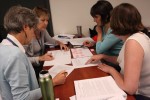
Our Workshops
We are recruiting faculty for upcoming workshops for 2013 (Session I - June 10 - 14; Session II - June 17 - 21). Workshops will be held at Hobart and William Smith Colleges in Geneva, NY.
more »
Curricular Resources
Submit or view roadmaps detailing how to use the C.R.E.A.T.E. strategy in a specific course or course level
more »
Student Voices
"The traditional way, science is like a set-up. Somebody has already set it up. And you are limited in your thinking. You go along those lines. They tell you, “do this, do that, do this, do that”
more »
The C.R.E.A.T.E. (Consider, Read, Elucidate the hypotheses, Analyze and interpret the data, and Think of the next Experiment) method is a new teaching approach that uses intensive analysis of primary literature to demystify and humanize research science for undergraduates. Our goal is to use the real language of science—the journal article—as an inroad to understanding “who does science, how, and why?” At the same time, we wish to help students (1) experience authentic processes of science, in particular discussion/debate about experimental data and their interpretation (including ‘grey areas’), (2) recognize the creativity and open-ended nature of research, and (3)see the diversity of people who undertake research careers (i.e. not just the genius/geeks of popular culture). As a complement to teaching based on textbooks, which tend to oversimplify the research process,C.R.E.A.T.E. teaching focuses on on authentic published work–peer reviewed journal articles—with students reading either series of papers produced sequentially from individual labs or series of papers from different labs focused on a single line of research.
By reading/analyzing a set of papers published in series from a single lab, students experience the evolution of research projects over a period of years. Using newly-developed C.R.E.A.T.E. pedagogical tools, that encourage multiple approaches to the material (concept mapping, sketching, visualization, transformation of data, creative experimental design) students gain deep understanding of the methods (and biological content/principles) that underlie each individual experiment of the paper. In class, we emphasize scientific thinking–focusing on understanding both why and how each part of the study was done, by examining the hypotheses underlying each aspect of the study, and analyzing/discussing the data represented in each figure and table. Students learn to interpret complex data, draw conclusions, debate interpretations, and re-represent data (e.g. represent tabled data in graphic form) to aid understanding. Content knowledge is reviewed as students consider the principles underlying the techniques used, as well as the overall context of the scientific question being addressed (e.g. a module focused on regeneration would likely include review multiple aspects of cell division, cell differentiation, gene expression and stem cells, drawing on information students learned in other classes and helping them to apply it in a real-world research situation). C.R.E.A.T.E. students thus learn a variety of transferable learning skills that can be applied to complex scientific reading they do in the future. Students design their own proposed followup experiments at several points in the semester, and debate each other’s proposed studies in a classroom exercise modeled on activities of bona fide scientific grant panels. Such discussions reveal the research process to be open ended, with multiple branch points or possible “next directions to go;” thus much less linear and predictable than many students expect. Late in the process, students generate a short list of questions for paper authors that are sent as an email survey to each author (not simply the PI). Responses from multiple authors provide unique behind-the-scenes insight into “the people behind the papers,” humanizing the research experience and showing researchers to be complex individuals much like the students themselves .
Modifications of the method have been devised based on newspaper/Internet science as well as popular press discussions of science research, and used with high school or general education science students(Hoskins, 2010, 2011). Other modifications or reading and comparing papers published back-to-back that report the ‘same’ finding made through divergent approaches, or focusing on studies whose conflicting data led to a paradigm shift (Hoskins, 2008).
C.R.E.A.T.E. Effects on Students and Faculty
Evaluation of students in C.R.E.A.T.E. classes shows that the method enhances students’ critical thinking and content integration skills while at the same time improving attitudes toward scientists and research careers (Hoskins et al., 2007). C.R.E.A.T.E. students also show pre/post course gains in self-reported ability to read/analyze papers, attitudes about science, and confidence in their ability to think like scientists. Interestingly, students’ conceptions of the nature of knowledge also shift during the C.R.E.A.T.E. semester, with aspects of epistemological beliefs shifting toward a more mature view (Hoskins, Lopatto and Stevens, 2011). That is, students who start the semester believing knowledge is certain and ability innate, leave with a deeper understanding of authentic practices of science, as well as a more mature understanding of the nature of science.
Faculty teaching C.R.E.A.T.E. are freed from the tedium of lecturing as most of the course runs more like a lab meeting/discussion. While 10 minute lectures may be used to fill in gaps (e.g. how are monoclonal antibodies made?), most of the class is devoted to examining the universal logic of data analysis through close focus on experimental design and the interpretation of results—figures and tables. Students learn to fill in content gaps in preparation for class, freeing faculty from the “human Google” role and allowing them to bring their insider understanding of the research process to the classroom (see Hoskins and Stevens, 2009 for a discussion of advantages of this teaching approach for faculty).
History of the Project
The C.R.E.A.T.E. project has been supported by the National Science Foundation since 2003, originally by the Course, Curriculum and Laboratory Enhancement program (now called Transforming Undergraduate Education in Science). Our CCLI type 1 grant of 2003-5 (S.G. Hoskins and L.M. Stevens) allowed development and pilot-testing of the grant at CCNY. Our CCLI Type 2 expansion grant of 2006-10 (Hoskins and Stevens) allowed us to teach a group of 20 faculty from the NY/NJ/CT/PA area to teach C.R.E.A.T.E. style, then follow a subset as they applied the approach on their home campuses. Results indicate that on all campuses where it has been tested to date, the C.R.E.A.T.E. method improves critical thinking/content understanding while at the same time teaching students a great deal about the nature of science and the research life, enhancing metacognition, and supporting the maturation of epistemological beliefs (Stevens, Lopatto and Hoskins, in preparation). The current project, also NSF-supported through the TUES program (S. Hoskins and K. Kenyon), will expand C.R.E.A.T.E. nationally in both 4 year and community colleges.
Modifying C.R.E.A.T.E. for First Year Students
Based on recommendations of CCNY C.R.E.A.T.E. students, we are currently testing a new C.R.E.A.T.E course adaptation for first-year students. Supported by a TUES type 1 grant, S.H. is at present piloting a first-year C.R.E.A.T.E. course in fall 2011 at CCNY, testing whether introducing students to C.R.E.A.T.E. tools and approaches earlier in their careers will facilitate their persistence in STEM majors, better performance in core science courses, and increased likelihood of participation in undergraduate research experiences in later college years. The first-year C.R.E.A.T.E. course (termed C.R.E.A.T.E. CORNERSTONE) could be adapted to first year community college students as well.
Modifying C.R.E.A.T.E. for Other Pedagogical Purposes
Our published work focuses on classes in which C.R.E.A.T.E. modules consisted of multiple papers published by individual labs. While this method has certain advantages, other adaptations include reading a series of papers from different labs, focused on the same topic, reading papers that outline the history of a project across several decades, or reading papers published back-to-back because they reached similar conclusions, usually through quite distinct methods. We have also modified C.R.E.A.T.E. for shorter-term applications, for example examination of newspaper articles about scientific topics (Hoskins, 2010), or focusing on papers published pre/post a paradigm shift (Hoskins, 2008). Our initial study applied C.R.E.A.T.E. for a full semester in an elective course for juniors/seniors at CCNY. Faculty who learned C.R.E.A.T.E. in the 2007-8 workshops adapted the approach to a variety of courses, implementing the method for varying periods of time. Because the process is iterative, we feel students benefits most when the approach is used for a minimum of a month, in undergraduate courses though as noted above some focused short-term applications of C.R.E.A.T.E. teaching approaches have been devised and used effectively in workshops for high school students or individual class sessions of courses for gen-ed science students.
